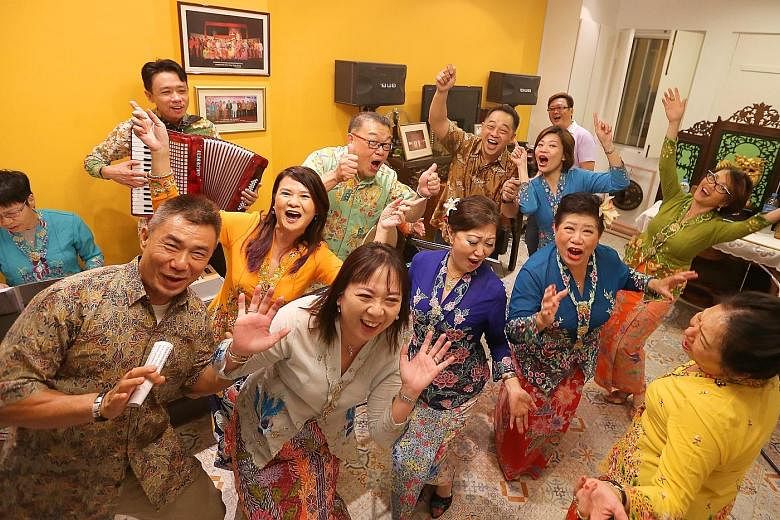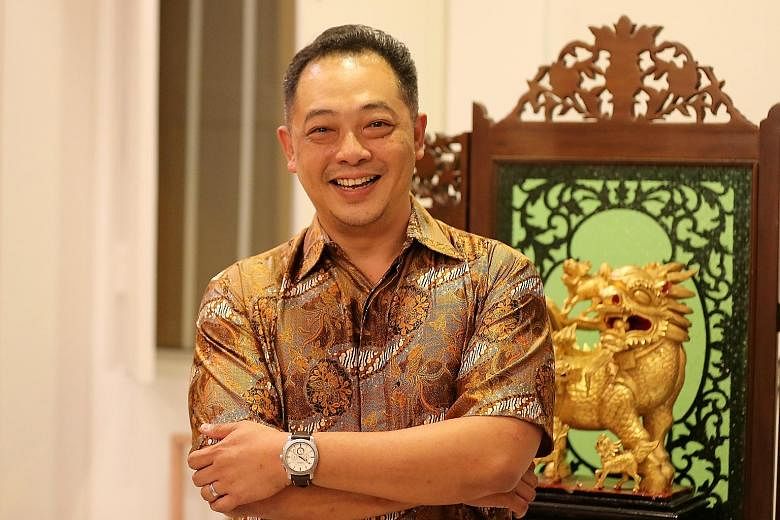The Gunong Sayang Association (GSA), a Peranakan cultural group, has staged productions almost annually in the Peranakan language since 1984.
Their productions span a wide range of genres, from musicals to tragedies to dramas. In 2009, it put on Ayer Pasang, Ayer Surut (literally "high tide, low tide", meaning "Good Times, Bad Times").
Starring in a key role was Mr Eugene Tay, who confessed to The Straits Times recently that he had been confused and horrified, as he did not speak the Peranakan language at the time.
"I was signed up by a friend," said the 38-year-old Peranakan.
But the experience started a passion for the language that still burns today.
It has been almost eight years since the entrepreneur acted in the play, and as he looked through photos of his performance, he highlighted a particular scene and recalled his colourful line: "Lu mia mulot tak mati!"
It literally means "your mouth won't die", and is something that Peranakans say when another person is being argumentative.
The Peranakan language is called "Peranakan Patois", or simply "Peranakan", within the community.
To outsiders and modern researchers, it is more popularly called "Baba Malay", a term that came into existence only in the 1970s.
Peranakan is a language that is colourful in its phrases and idioms. For example, pantat panjang, literally "long buttocks", means "to overstay one's visit".
To those unfamiliar with Peranakan, it may superficially sound and look like Malay.
But pay closer attention, and you will notice some interesting differences in vocabulary and pronunciation.
"Window" in Malay is jendela, but speakers of this tongue will say menjela. Both words come from the Portuguese word janela.
When calling somebody "smart", instead of saying that they are pandai (rhyming with the English word "die"), Peranakan speakers will say that they are panday (rhyming with the English word "day").
-
Peranakan facts
-
ORIGINS
Peranakan dates back to the 15th century, when Hokkien-speaking traders from the Zhangzhou and Quanzhou parts of Fujian province in China settled in the Malayan peninsula - particularly in ports like Malacca - and married local women who spoke Malay.
The language overlays Malay words on Hokkien grammar.
Many Singapore Peranakan-speakers came here from Malacca after the 1820s as it began to decline as a port relative to Singapore, which had started to thrive as a British trading port.
Malacca Peranakan and Singapore Peranakan are mutually intelligible, though Singapore's variety is more Hokkien-influenced while Malacca's features more Malay.
The Peranakan which evolved in Indonesia (known to researchers as Peranakan Indonesian) is based on Javanese and evolved separately, and cannot be understood by Peranakan speakers here.
-
NUMBER OF PERANAKAN SPEAKERS IN SINGAPORE
There are estimated to be fewer than 1,000 fluent speakers here. -
WHERE TO LEARN IT
The Gunong Sayang Association is starting classes for Peranakan next month. For more information, you can visit its Facebook page at www.facebook.com/GunongSayangAssociation/ -
FOOD
Some Peranakan dishes are:•itek-tim (a duck soup whose Teochew parallel is "kiam chye ah");
•ayam buah keluak (black nut stewed chicken);
•babi pongteh (braised pork in fermented soya bean);
•ayam sioh (chicken with coriander and tamarind gravy);
•and, of course, Peranakan kueh, like ang ku kueh.
And there is Hokkien in there, too - Dad's elder brother is pek, while his younger brother is chek.
Most of Peranakan's grammatical structure comes from Hokkien, much like how Singlish now overlays English, Chinese, Malay and Tamil words onto Chinese grammar.
It is indigenous to the Malay Peninsula, originating in the 15th century through the marriages of Hokkien-speaking traders from China's Fujian province and local women who spoke Malay in ports like Malacca.
The descendants of these unions became what we know today as the Chinese Peranakans, and their language is what we know today as Peranakan.
National University of Singapore Assistant Professor Nala Lee said that the tongue used to be called a "broken language" by some, particularly the British, during the colonial period.
However, Prof Lee, 33, whose doctoral dissertation was on Peranakan grammar, said that it is a full-fledged language with rules and a set grammar.
She added: "A different thing I've heard from some speakers is that their ancestors came from Malacca to avoid having to maintain their ancestral altars and halls, since many of them had converted to Catholicism due to colonial influence. This, however, is more speculative."
The Chinese Peranakan community has always been small, with an 1881 census recording 9,527 of them here.
They are now categorised as "Chinese" for official purposes, and according to Prof Lee, the language's heyday was in the mid-1800s.
Since then, it has declined in use, with fewer than 1,000 fluent speakers today.
Prof Lee said that Peranakan is "virtually moribund - it is not being spoken by children".
Some in the community say that the Speak Mandarin Campaign, which began in 1979, played a significant role in its decline.
GSA president Alvin Teo, 51, said: "I remember I was forced to study Mandarin, and when I begged my dad to let me study Malay instead, he said, 'No, we are Chinese.'"
Mr Teo explained that, as someone who spoke Peranakan at home, the Malay language would have been much easier to learn in school.
But Prof Lee said that there were other, deeper reasons.
"The real threat to the language was with the establishment of English-medium schools during the period of British administration, since the Peranakans embraced English-medium education and British culture, to the extent of calling themselves the 'King's Chinese' at one point in time," she said.
Regarding the association of Peranakan's decline with the Speak Mandarin Campaign, she noted: "It is most probably because of how it's been a real thing for most other Chinese dialect communities, and it's not been that long ago.
"So it is most probably easier for the public to point to it, than (to) something that happened in the 19th century."
Happily, members of the community can also point to a recent revival. Mr Frederick Soh, a Baba who was the GSA's first vice-president, said that the trend started in 2008, when the Peranakan Museum opened and The Little Nyonya burst onto the local TV scene.
And Prof Lee thinks the revival has been even more recent, citing a panel discussion last year on the language. The event brought together people who found that they wanted to revive it.
Mr Soh, 49, said he felt optimistic, noting that the GSA will begin offering Peranakan lessons next month, thanks to increased interest from younger Peranakans.
The association's cultural adviser, Mr Victor Goh, hopes that the students in those classes will find opportunities to speak the language.
"The key word is sustainability," said the 71-year-old Baba. "It's a brave start, but it's a good start."
Mr Peter Wee, the president of the Peranakan Association, was more guarded.
He said that the current generation "has to take its own initiative" to "reinterpret" Peranakan.
"If this younger generation wants to teach and propagate it, so be it," said Mr Wee, 71.
And the younger generation does indeed want to keep the language going.
Said Prof Lee: "As the granddaughter of a very Peranakan man who loved reading cherita dulu kala (Chinese classics translated into Peranakan) and singing dondang sayang (a form of Peranakan poetry adapted from Malay), the language serves as a resolute connection to my heritage."



